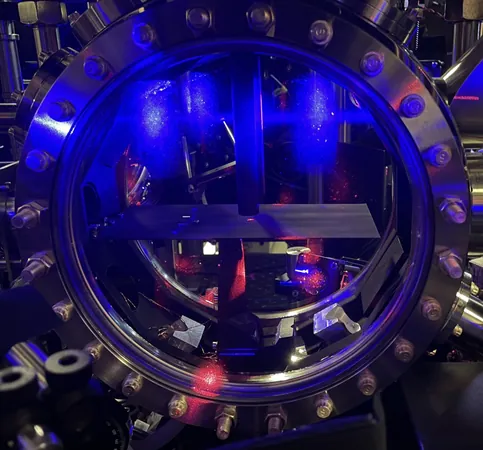
Unveiling the Future: Breakthrough in Continuous Lasing Using Laser-Cooled Strontium Atoms
2025-05-05
Author: Arjun
A Revolutionary Leap in Quantum Physics
In an astonishing breakthrough, researchers at JILA, a collaborative institute of the University of Colorado-Boulder and the National Institute of Standards and Technology, have achieved hours-long continuous lasing by utilizing laser-cooled strontium-88 atoms within a unique circular optical cavity. This groundbreaking discovery was published in the prestigious journal *Nature Physics* and could herald a new era for ultra-quiet lasers, quantum computing, and precision sensing technologies.
Harnessing the Power of Quantum-Behaved Atoms
Laser-cooled atomic gases, which are gases of atoms chilled to near absolute zero using cutting-edge laser techniques, have emerged as powerful tools for exploring and controlling quantum phenomena. When these gases interact with light in specially designed environments, they can trigger remarkable effects, paving the way for innovative applications such as quantum sensing and highly intricate quantum simulations.
A Quest for Continuous Superradiant Lasers
The primary goal of the team was to create a continuous superradiant laser—an instrument capable of executing exquisite frequency measurements in brief timeframes. According to Dr. Vera M. Schäfer, the lead author, this advancement could significantly enhance efforts to explore dark matter and other enigmatic aspects of physics.
Unexpected Discoveries in Lasing Mechanisms
While embarking on their ambitious project, the researchers encountered an unexpected phenomenon: they observed laser light emerging from their system without deliberately inducing it. Professor James K. Thompson likened their setup to a bell for light rather than sound, where the gas atoms unwittingly made this 'bell' resonate, yielding fascinating findings about the stability of light frequencies.
Pioneering Continuous Cooling Techniques
What sets this research apart is their innovative approach to continuously cooling and loading strontium atoms, diverging from traditional methods that often involve staggered processes. Senior PhD student Zhijing Niu highlighted their unique methodology which enabled the atoms to remain consistently cooled, ultimately facilitating prolonged lasing effects.
New Insights into Light-Matter Interactions
Through their explorations, the research team uncovered a fascinating gain mechanism involving photon absorption and stimulated emission, which contributed to the continuous lasing effect. This phenomenon reshapes our understanding of how energy dynamics function within atomic systems.
Implications for Quantum Technologies
The implications of this research extend far beyond the laboratory. The continuous lasing properties observed in this study could lead to advancements in technologies like atomic clocks and gravitational wave detectors, which rely on optical cavities with exceptional frequency stability.
Shifting the Paradigm in Atomic and Laser Physics
Inspired by their findings, scholars in the field of atomic and laser physics are increasingly pivoting from cyclical approaches to continuous experiments. This shift could open the doors to advanced technological applications, including high-performance quantum computing systems and precision optical tools.
Looking Ahead: What the Future Holds
As the research team continues its work, they aim to exploit the narrow linewidth transition of strontium to develop extraordinary single-color lasers. These innovations could lead to the exploration of new realms in physics, including utilizing collective effects to protect quantum sensors against disturbances and simulating complex superconducting states.
The future is bright for JILA and the world of quantum technology. This research is just the beginning of a thrilling journey into the mysteries of quantum mechanics, with researchers ready to dive into uncharted waters.

 Brasil (PT)
Brasil (PT)
 Canada (EN)
Canada (EN)
 Chile (ES)
Chile (ES)
 Česko (CS)
Česko (CS)
 대한민국 (KO)
대한민국 (KO)
 España (ES)
España (ES)
 France (FR)
France (FR)
 Hong Kong (EN)
Hong Kong (EN)
 Italia (IT)
Italia (IT)
 日本 (JA)
日本 (JA)
 Magyarország (HU)
Magyarország (HU)
 Norge (NO)
Norge (NO)
 Polska (PL)
Polska (PL)
 Schweiz (DE)
Schweiz (DE)
 Singapore (EN)
Singapore (EN)
 Sverige (SV)
Sverige (SV)
 Suomi (FI)
Suomi (FI)
 Türkiye (TR)
Türkiye (TR)
 الإمارات العربية المتحدة (AR)
الإمارات العربية المتحدة (AR)